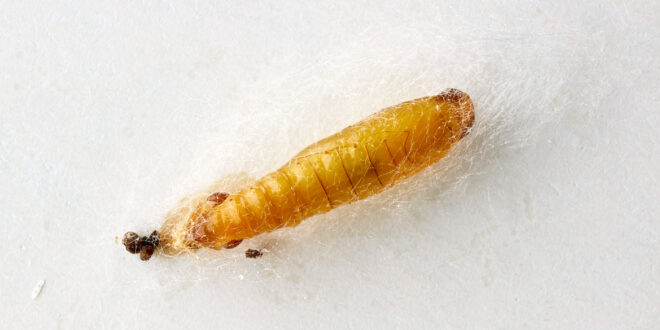Fine cobweb-like threads entangled among clumped, stored, dried goods are no fun to discover. Even worse is the sight of small, wriggling white worms. If this sounds like your pantry, the culprit will almost certainly be the pantry moth. This small, silver-brown ‘Meal Moth’ can sometimes be seen fluttering around the kitchen, or crawling across the floor. It is especially active and at its height of egg-laying in warmer temperatures below 40C. Although the adult moth doesn’t eat, it does require a food source for the larva (worms) that hatch from its eggs. This is why it chooses to lay its eggs in stored dried goods, including flours, meals, pasta, lentils, biscuits, dried fruit, and seeds (including bird seed).
Pantry moths can arrive in our homes by flying in from outdoors, but more commonly, their eggs (the adult can lay up to 400 or 500 at a time) arrive on the goods we have purchased and brought home. Each egg is round and white, and just half a millimetre long, so you’re unlikely to spot it at this early stage. The larvae, on the other hand, can grow up to 2 cm long. If we don’t spot these small, cream-coloured worms chewing their way through our dried food, we may well find them tucked inside their silk cocoons, ‘glued’ to the walls of kitchen cupboards, waiting to develop into moths.
If you’re wondering how the pantry moth infiltrates supermarket foods, it’s because it is capable of chewing its way through plastic and cardboard packaging. If the damage goes undetected by shelf-stockers, the moth is home and hosed. Once you have pantry moths in your home, it’s unlikely they will disappear of their own accord. Their eradication will be up to you. For tips on how to oust these pesky pests, check out our tips, below:
Pantry Storage Tips
- Store dried foods in glass containers – pantry moths can’t chew through them as they can with soft packaging.
- Clean up shelf-spills! Dried foods spilt onto kitchen shelves attract pantry moths. Inspect your shelves frequently, and wipe or vacuum up any spills as soon as they occur.
- As you clean, use a solution of white vinegar to wipe down shelves, walls, doors, and stored goods packets and containers. Use a long-bristled scrubbing brush to reach into any cracks where eggs (and moths) may be hiding. Re-wipe all surfaces with warm water.
- Make sure you check your herbs and spices! They love to snuggle into the paper folds and cardboard boxes the spices come in!
- Don’t discard moth-infected dried goods into your kitchen bin. The eggs may hatch before you take the bin outside, setting you up for a new round of egg-layers.
- Instead of topping-up containers of dried food, use up the entire contents first, then thoroughly wash and dry the container before reusing. That way, any moth contamination won’t be carried over into the new dried goods.
- When you bring home dried food from the supermarket, store it, sealed in a zip-lock bag, in the freezer for 24 hours before unpacking it into air-tight containers. This will kill any moth eggs present in the packets. If you are buying in bulk, store dried food not immediately in use in the freezer or in a sealable tub.
- Check in hidden places, such as down the back of chairs and behind beds (especially after the grandchildren have been visiting!) for any crumbs or pieces of food. These spots are all places where pantry moths will head to lay eggs.
- Essential oils (such as lavender, thyme, peppermint, and clove) may help deter the pantry moth from your kitchen cupboards. However, be aware that essential oils also have the potential to taint foods.
- You can also find eco-friendly pantry moth traps, like this one, which attract the adult moths and stop them from laying eggs.









Join the Discussion
Type out your comment here:
You must be logged in to post a comment.